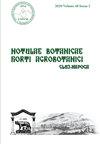Perennial forage legumes as an element of sustainable systems
IF 1.3
4区 生物学
Q3 PLANT SCIENCES
引用次数: 0
Abstract
In the current intensive systems of agricultural production, many important features, i.e., functions of the agroecosystem have been degraded and disrupted. The intensification of agricultural production inevitably leads to land degradation in terms of its physical, chemical, and biological properties. The increasing presence of monocultures, reduced crop rotation, and excessive use of mineral nutrients, lead to several negative phenomena in such agroecosystems. Along with efforts to reduce energy consumption, and environmental pollution, intensify sustainable agriculture systems, and maintain biodiversity, the possibility of increasing the area under perennial forage legumes should be considered. As nitrogen fixers, these plants are minimally fertilized with nitrogen fertilizers whose residues in the soil are lost by leaching, causing pollution of groundwater as well as surface watercourses. The introduction of perennial legumes in the crop rotation can provide numerous benefits, such as increased and more stable yields of protein-rich biomass, conservation, and repair of land resources, increased yield stability, better utilization of nutrients, water, and light, as well as weed, disease, and pest control. The introduction of legumes in production systems would limit the increasingly pronounced land degradation. In order to develop sustainable agriculture, market policy should recognize the value of products obtained from leguminous plants through certain agricultural policy measures.多年生牧草豆科植物作为可持续系统的一个要素
在当前的集约化农业生产体系中,农业生态系统的许多重要特征,即功能已经退化和破坏。农业生产的集约化不可避免地导致土地在物理、化学和生物特性方面的退化。单一栽培的增加、作物轮作的减少和矿物养分的过度使用,导致这种农业生态系统出现了一些负面现象。在努力减少能源消耗和环境污染、强化可持续农业系统和保持生物多样性的同时,应考虑增加多年生饲草豆科植物种植面积的可能性。作为固氮剂,这些植物很少施用氮肥,土壤中的氮肥残留物因淋滤而流失,造成地下水和地表水的污染。在作物轮作中引进多年生豆科植物可以提供许多好处,例如增加和更稳定的富含蛋白质的生物量产量,保护和修复土地资源,提高产量稳定性,更好地利用养分、水和光,以及控制杂草、疾病和害虫。在生产系统中引进豆科植物将限制日益明显的土地退化。为了发展可持续农业,市场政策应通过一定的农业政策措施,承认豆科植物产品的价值。
本文章由计算机程序翻译,如有差异,请以英文原文为准。
求助全文
约1分钟内获得全文
求助全文
来源期刊

Notulae Botanicae Horti Agrobotanici Cluj-napoca
PLANT SCIENCES-
CiteScore
2.70
自引率
0.00%
发文量
118
审稿时长
3 months
期刊介绍:
Notulae Botanicae Horti Agrobotanici Cluj-Napoca is a peer-reviewed biannual journal aimed at disseminating significant research and original papers, critical reviews and short reviews. The subjects refer on plant biodiversity, genetics and plant breeding, development of new methodologies that can be of interest to a wide audience of plant scientists in all areas of plant biology, agriculture, horticulture and forestry. The journal encourages authors to frame their research questions and discuss their results in terms of the major questions of plant sciences, thereby maximizing the impact and value of their research, and thus in favor of spreading their studies outcome. The papers must be of potential interest to a significant number of scientists and, if specific to a local situation, must be relevant to a wide body of knowledge in life sciences. Articles should make a significant contribution to the advancement of knowledge or toward a better understanding of existing biological and agricultural concepts. An international Editorial Board advises the journal. The total content of the journal may be used for educational, non-profit purposes without regard to copyright. The distribution of the material is encouraged with the condition that the authors and the source (Notulae Botanicae Horti Agrobotanici Cluj-Napoca or JCR abbrev. title Not Bot Horti Agrobo) are mentioned.
 求助内容:
求助内容: 应助结果提醒方式:
应助结果提醒方式:


